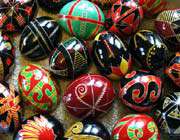Pysanka
A pysanka is a Ukrainian Easter egg, decorated using a wax-resist (batik) method. The word comes from the verb pysaty, "to write", as the designs are not painted on, but written with beeswax.
Many other eastern European ethnic groups, including the Belarusians (???????), Bulgarians (?????? ????, pisano yaytse), Croats (pisanica), Czechs (kraslice), Lithuanians (margitis), Poles (pisanka), Romanians (ou? vopsite or "incondeiate"), Slovaks (kraslica), and Slovenians (pisanica or pirh) decorate eggs for Easter. Types of decorated eggsPysanka is often taken to mean any type of decorated egg, but it specifically refers to eggs created by the written-wax batik method. Several types of decorated eggs are seen in Ukrainian tradition, and these vary throughout the regions of Ukraine.
Krashanky are boiled eggs dyed a single color (with vegetable dyes), and are blessed and eaten at Easter.
Pysanky (from pysaty, "to write") are raw eggs created with the wax-resist method (batik). The designs are "written" in hot wax with a stylus or a pin-head. Wooden eggs and beaded eggs are often referred to as "pysanky" because they mimic the decorative style of pysanky in a different medium.
Krapanky (from krapka, "a dot") are raw eggs decorated using the wax-resist method, but with only dots as ornamentation (no symbols or other drawings)
Dryapanky (from dryapaty, "to scratch") are created by scratching the surface of a dyed egg to reveal the white shell below.
Malyovanky (from malyuvaty, "to paint") are created by painting or coloring (e.g. with a marker) on an egg.
Lystovanky (from lystya, "leaves") are created by dyeing an egg to which small leaves have been attached.
All but the krashanky are usually meant to be decorative (as opposed to edible), and the egg yolk and white are either allowed to dry up over time, or removed by blowing them out through a small hole in the egg. Some of the others, most notably the krapanky, are referred to by some as "pysanky", but that is not the correct usage of the term. History
The world"s largest pysanka was erected in Vegreville, Alberta in 1974, commemorating the 100th anniversary of the Royal Canadian Mounted Police.
The art of the decorated egg in Ukraine, or the pysanka, dates back to ancient times. As in many ancient cultures, Ukrainians worshipped a sun god (Dazhboh). The sun was important - it warmed the earth and thus was a source of all life. Eggs decorated with nature symbols became an integral part of spring rituals, serving as benevolent talismans.
In pre-Christian times, Dazhboh was one of the main deities in the Slavic pantheon; birds were the sun god"s chosen creations, for they were the only ones who could get near him. Humans could not catch the birds, but they did manage to obtain the eggs the birds laid. Thus, the eggs were magical objects, a source of life. The egg was also honored during rite-of-Spring festivals––it represented the rebirth of the earth. The long, hard winter was over; the earth burst forth and was reborn just as the egg miraculously burst forth with life. The egg, therefore, was believed to have special powers.
With the advent of Christianity, the symbolism of the egg changed to represent, not nature"s rebirth, but the rebirth of man. Christians embraced the egg symbol and likened it to the tomb from which Christ rose. With the acceptance of Christianity in 988, the decorated pysanka continued to play an important role in Ukrainian rituals of the new religion. Many symbols of the old sun worship survived and were adapted to represent Easter and Christ"s Resurrection.

Today, pysanky are made at Easter time by Ukrainians around the world. SuperstitionsThe Hutsuls––Ukrainians who live in the Carpathian Mountains of Western Ukraine––believe that the fate of the world depends upon the pysanka. As long as the egg decorating custom continues, the world will exist. If, for any reason, this custom is abandoned, evil––in the shape of a horrible serpent who is forever chained to a cliff–– will overrun the world. Each year the serpent sends out his minions to see how many pysanky have been created. If the number is low the serpent"s chains are loosened and he is free to wander the earth causing havoc and destruction. If, on the other hand, the number of pysanky has increased, the chains are tightened and good triumphs over evil for yet another year.
Superstitions were attached to the colors and designs on the pysanky. One old Ukrainian myth centered on the wisdom of giving older people gifts of pysanky with darker colors and/or rich designs, for their life has already been filled. Similarly, it is appropriate to give young people pysanky with white as the predominant color because their life is still a blank page.
Another Ukrainian superstition insists that girls should never give their boyfriends pysanky that have no design on the top and bottom of the egg; the baldness on either end signifies that the boyfriend will soon lose his hair.
Christian legends
Old legends blended folklore and Christian beliefs and firmly attached the egg to the Easter celebration. One legend concerns the Virgin Mary. It tells of the time Mary gave eggs to the soldiers at the cross. She entreated them to be less cruel and she wept. The tears of Mary fell upon the eggs, spotting them with dots of brilliant color.
Another legend tells of when Mary Magdalene went to the sepulchre to anoint the body of Jesus. She had with her a basket of eggs to serve as a repast. When she arrived at the sepulchre and uncovered the eggs, the pure white shells had miraculously taken on a rainbow of colors.
encyclopedia.thefreedictionary.com
Other Links:
Fantastic Sally Swatland Paintings (Photo Gllery)
Photo Gallery:Beautiful Wall Paintings (Part 2)
Photo Gallery:Beautiful Wall Paintings (Part 1)